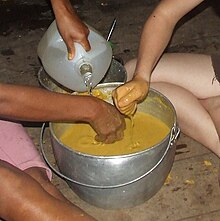Chicha
Chicha ( ˈtʃi.tʃa ) is a beer from the entire Andean region of South America , which was already drunk by the Incas and is generally obtained by fermenting various plants with saliva ( amylases in saliva break down corn starch into sugar), hence the name " Spit beer ".

The origin of the word is not completely clear. According to the Royal Spanish Academy of Language and other authors, chicha is derived from the word chichab , a word in the Kuna language that means "corn". According to other sources, chicha comes from the Nahuatl word chichiatl , which means “fermented water”. The name Chicha was used by the Spaniards for all fermented drinks they encountered in America, even if different locally available ingredients were used for the preparation.

In the Inca Empire , chicha was made from maize , especially from sprouted maize ( Jora or Wiñapu ), but also from quinua , amaranth , Kañiwa , Oca , Chañar and Molle, etc. a. manufactured. In Quechua the drink is called aqha . Flatbreads made from cornmeal were chewed through by the women, so soaked with a lot of saliva. The starch is quickly converted into sugar by the enzymes present in the saliva , the solution of which then easily goes into fermentation . The alcohol content of Chicha ranges from 1 to 6 % vol. , Depending on whether the drink was made for daily consumption during work or for parties such as the Inti Raymi . The Inca Garcilaso de la Vega explains that excessive drinking was one of the main vices of the people. Numerous other contemporary texts also attest to the use of chicha as an everyday and festive drink.
The Shuar and other indigenous peoples of the Amazon lowlands traditionally produce a form of chicha from yuca (manioc) or the fruits of the peach palm (chonta). Both raw materials are cooked until soft and then mashed before parts of the mass (usually by a woman) are chewed and put back into the pot. Then water is added while the fruit mass is wrung out with your hands and sifted. Finally, the drink is left to ferment for at least a day. Traditionally, the chicha is kept in a hollowed-out bottle gourd .
Chicha morada is an alcohol-free variant . For this purpose, purple corn is boiled and cold, refined with sugar and lime juice , drunk as lemonade.
The rice chicha is particularly widespread in Venezuela . This variant is prepared by mixing rice with slightly fermented pineapple peel and "Papelón" ( cane sugar , is crystallized in plates) is cooked together, he can hold up no more water. Then the remaining liquid is pureed with the rice, so that a thick drink is created. This is then left to ferment for a few days, depending on taste. The rice chicha with milk is an alcohol-free variant. This is a cold soft drink that is sold a lot on the streets. It is made with milk instead of water and without pineapple and served with cinnamon and sweet condensed milk , so it is a kind of rice pudding milkshake.
In Chile , especially in central Chile, chicha is made from fermented apples. The drink is similar to cider . It is drunk in autumn and on national holidays and is very popular. In Curacaví , chicha is made from grapes. These two drinks are therefore not to be classified as beers, but as wine or wine-like drinks.
The Peruvian form of cumbia was colloquially named after the drink .
Individual evidence
- ^ Karen Bescherer Metheny, Mary C. Beaudry: Archeology of Food. Rowman & Littlefield, 2015, ISBN 978-0-7591-2364-9 , p. 97.
- ^ Lieselotte and Theodor Engl: The conquest of Peru in eyewitness reports. Deutscher Taschenbuch Verlag, Munich 1975, ISBN 3-423-01100-9 .
literature
- Rosario Olivas Weston: La Cocina de los Incas. Universidad de San Martín de Porres, Lima 2006, ISBN 9972-54-062-6 (Spanish).
Web links
- Chasqui, Cultural Gazette of the Peruvian Foreign Ministry, July 2005, Year 3, Number 7 ( Memento of February 12, 2007 in the Internet Archive ) (PDF, German; 1.98 MB)
